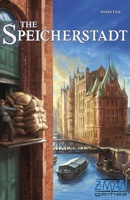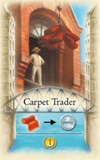
|
About OgreCave and its staff
|

|
by Demian Katz
This game is featured in the OgreCave Christmas Gift Guide 2010. Stefan Feld came to my attention through his prolific output in Alea's popular "big box" series of relatively high-complexity Eurogames, to which he has been a frequent contributor in recent years with titles like Notre Dame and In the Year of the Dragon. His latest offering, The Speicherstadt, is not part of the Alea line, but it is of consistent quality with his work there. "I don't care about Stefan Feld or Alea big boxes," I can hear you saying. "What is a Speicherstadt?" Well, it is the warehouse district of Hamburg. Yes, this is another German game about moving boxes around in Germany. Fortunately, like most games of its type, it is a lot more fun than its theme gives it any right to be.
Gameplay At the start of the game, players are each given a market hall card, three wooden workers and five cardboard coins. A separate, nicely-detailed metal version of the cardboard coins is used as a start player marker. The remaining cards are divided between the four seasons of the year. Each season is shuffled separately, then the seasons are stacked in order with Winter on top – this ensures that certain cards always come into play before certain other cards. The board is laid at the center of the table, though it doesn't have many complex features, serving only as a scoring track and a place to lay down cards and auction bids. Each turn, a number of cards equal to the player count plus one is laid out on the board. Players take turns placing their worker markers above the cards until all workers are on the board. After workers are placed, card sales are resolved from left to right. The first player to place a worker on a card has the first chance at buying it, but also has to pay the most. If one person decides not to buy the card, the next person in line has an opportunity to buy at a lower price. For example, suppose the queue of workers above a card is Player 1 followed by Player 2 followed by Player 1. Player 1 could immediately buy the card for three coins. If Player 1 passes, Player 2 may buy the card for two coins. If Player 2 now passes, Player 1 gets a second shot, this time at the low price of just one coin! Once all of the cards have been auctioned in this way, players take a few moments to make use of their new purchases, moving goods around or selling them as their cards permit. After that work is done, everyone earns income (1 coin for players who bought cards, 2 coins for players who went empty-handed), and another set of cards is laid out for the next auction. Obviously, it is the cards themselves that make all of this interesting. In most games, all game elements are in play from the start. Even in more dynamic titles, there are usually a small number of clearly defined phases that change the options available to the players. Here, the deck offers a rather large range of options, and many of them only come up once during the course of the game! This evolving variety of options allows the game's tone to shift with the seasons and offers many different strategic possibilities – there are many different ways to score, and you really can't plan on getting any particular cards, since if you miss certain opportunities, they're not coming back!
After this point, the remainder of the game becomes a battle to fulfill contracts, avoid fires and occasionally acquire rare special cards that offer unique opportunities for scoring points or gaining income. Once the deck runs out (always ending with the "fourth fire" card), players score their victory points for fulfilled contracts and various special cards, and the player with the most points wins. Cash on hand only serves as a tie-breaker, though at least one card (the Chamber of Commerce) converts money to victory points.
Conclusions Links:
|
||||
 The Speicherstadt
The Speicherstadt During the first season (Winter), options include various characters who
can convert goods to money, the game's single warehouse for storing
goods, and a handful of card types that show up throughout the following
seasons: firemen (worth bonus points when the game's periodic "fire"
cards pop up), contracts (which convert a specific set of goods into
victory points) and a single counting house (worth more victory points
the more counting houses you collect). It is not until Spring that ship
cards begin to show up bearing goods, thus opening up all the key
possibilities of the game. The market hall cards that players started
the game with can be used to convert between goods types and cash, and
additional cards earned during the course of play offer further
possibilities.
During the first season (Winter), options include various characters who
can convert goods to money, the game's single warehouse for storing
goods, and a handful of card types that show up throughout the following
seasons: firemen (worth bonus points when the game's periodic "fire"
cards pop up), contracts (which convert a specific set of goods into
victory points) and a single counting house (worth more victory points
the more counting houses you collect). It is not until Spring that ship
cards begin to show up bearing goods, thus opening up all the key
possibilities of the game. The market hall cards that players started
the game with can be used to convert between goods types and cash, and
additional cards earned during the course of play offer further
possibilities.